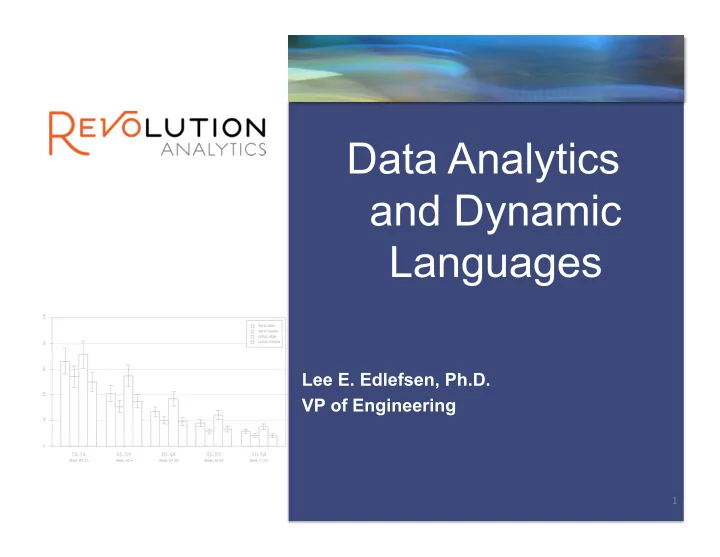

Data Analytics and Dynamic Languages Lee E. Edlefsen, Ph.D. VP of Engineering 1 ¡
Overview Revolution ¡Confidential This is my perspective on the use of dynamic languages (interpreters) for data analytics (statistics) I am a long-time user and commercial developer of dynamic languages for data analysis, but I am also a hard-core C++ programmer 2
Outline Revolution ¡Confidential A bit about my experience Good/bad things about dynamic languages for data analysis, with special focus on R Why statistics/data analytics requires its own language The importance of parallel and distributed computing for data analysis What I think would be the ideal language for statistics Revolution R Enterprise 3
Dynamic languages I have used and/or developed Revolution ¡Confidential APL – tried using to teach econometrics with it in early 1980’s MATLAB – tried using a very early version to teach econometrics in the early 80’s Gauss – designed, developed, and commercialized this matrix-oriented statistical system in mid-80’s Revolution R Enterprise 4
Dynamic languages I have used and/or developed -- 2 Revolution ¡Confidential Axum – designed and developed this commercial technical graphics package, and wrote a C-like interpreter for doing data transformations S-PLUS – was VP of Development for S- PLUS (at MathSoft) in late 90’s. S-PLUS is the commercial version of S. Revolution R Enterprise 5
Dynamic languages I have used and/or developed -- 3 Revolution ¡Confidential ExaStat – designed and developed this C++ based data analysis system that can be both interpreted (using CINT) and compiled Threading is built in for most array and matrix computations Includes a framework for automatically parallelizing and distributing a broad class of statistical algorithms R -- currently VP of Engineering at Revolution Analytics, which focuses on R Revolution R Enterprise 6
Features that make dynamic languages so nice for data analysis Revolution ¡Confidential Command line for quick experimentation Ability to work directly with arrays, sets of arrays, and matrices Environment for inspection of objects Availability of functions for doing common operations Natural syntax that corresponds to subject matter – don’t have to be a hard core programmer to get things done Revolution R Enterprise 7
More nice features Revolution ¡Confidential Reduced need to write loops Don’t have to worry about specifying data types No compile/link/load time No worries about memory allocation, pointers, headers, linking errors, loading problems Revolution R Enterprise 8
Problems with most dynamic languages for data analysis Revolution ¡Confidential Speed, especially compared with the best compiled code Loops tend to be especially slow Problems scaling with data size Often requires translation into compiled code before use in production environment Insufficient range of data types Lack of support for parallel and distributed computing Revolution R Enterprise 9
Especially nice features of R Revolution ¡Confidential Common language used by practitioners around the world Much of new statistics over the past 10-15 years has been implemented in R Easy ability to download and install new packages; thousands are available Excellent interface to compiled languages Functions available for doing almost anything data-related Revolution R Enterprise 10
Particular problems with R Revolution ¡Confidential Slow, especially for loops over data (about 100,000 times slower than C++ for simple loops) Memory hog; multiple copies of “read-only” data can be made during a simple analysis Not enough data types Encourages bad coding practices – especially use of globals Not thread-safe Revolution R Enterprise 11
Why statistics needs its own language(s) Revolution ¡Confidential A natural and familiar syntax is important It is necessary to have “data set” objects with column and row names, data descriptions, mixed data types Easy, fast I/O of these objects Missing value handling is crucial and must be built-in to almost all functionality Proper handling of categorical data is also critical Revolution R Enterprise 12
The importance of parallel and distributed computing in data analysis Revolution ¡Confidential Our ability to collect and store data is rapidly and greatly outpacing our ability to analyze that data To analyze all this data we must use multiple cores and multiple hard drives This means we need software that distributes computations across cores and computers and puts the results back together as if the work had been done on one core Revolution R Enterprise 13
My view of the ideal statistical language Revolution ¡Confidential Based on the R syntax, but fixing the main problems Implemented using LLVM or something similar Extended range of data types Allow passing objects by reference Perhaps allow type specifications to enable increased speed of loops over data Have built-in support for parallel and distributed computations Revolution R Enterprise 14
Recommend
More recommend